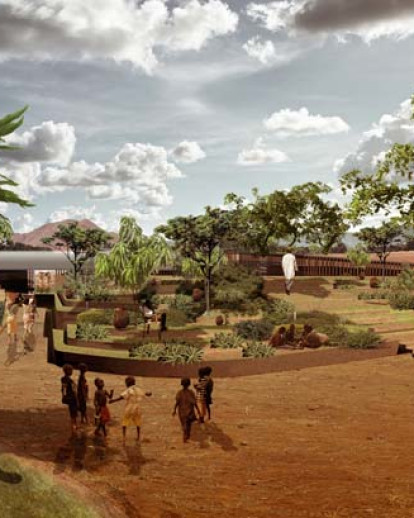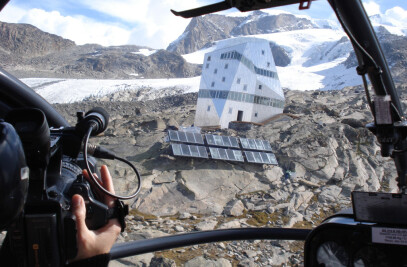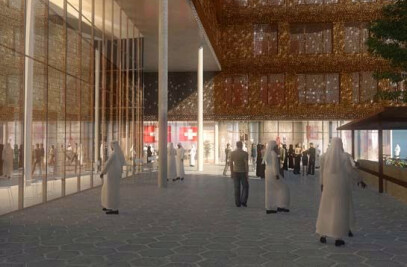Comment of the Holcim Awards jury Africa Middle East
The jury commended this project because of its broad approach towards enmeshing discreet sustainable aspects of the program into a comprehensive whole. The Secondary School Gando is constructed by the local community and builds not only a series of structures, but also a sense of identity and enhanced social cohesion. Its “urban design” has the potential to act as an anchor point in the village structure. The project, as one element of a long-term school development, makes use of “hightech” ideas that are implemented with low-tech means. It intelligently leverages the site’s characteristics and locally-available materials. The project itself generates positive impacts upon both the social environment by generating opportunities for education, creating jobs and training; and on the natural environment through reforestation. People learn building skills using clay and other readily available local materials, which strengthens the idea of a mutually-beneficial process since the skills learnt can be applied beyond the confines of the site. The experiences and techniques partially applied to earlier projects realized independently on the same site were integrated, and prove the potential and applicability of the project’s inherent ideas.
Project description by author
Burkina Faso is amongst the poorest countries in the world. With an illiteracy rate of over 80% the majority of its people has no alternatives to agriculture. The village of Gando - 3000 inhabitants - is situated 200km from Burkina Faso’s capital Ouagadougou. Born here as the son of the headman, Francis Kéré was the first to study abroad. He reinvested his knowledge as an architect into the urgently needed construction of a new school in his home village. Guided by principles of sustainable development, Kéré stressed the importance of clay as one of the main building materials. The Gando school project taught the local people how to refine clay and local materials, and how different construction techniques could further improve the performance. In 1998 Kéré founded “Schulbausteine für Gando” to raise private money and government support to replace Gando’s dark and small school in 2001. The school today has more than 350 pupils. The construction of teachers’ accommodation, with standards to match the school building, followed the school. It does not only provide education for the village children, it is also used to pass on new skills and knowledge to the entire community. Growing numbers of students created the necessity of a school extension which was completed in 2008. A public library is currently under construction.
The current project – Secondary School Gando – is giving the graduate students the accessibility to further education, and is therefore enhancing the sustainability of the educational opportunities created.
The extremely hot weather conditions in the area, makes studying in buildings without air-conditioning very difficult. That is why all interior spaces are embedded partially underground in the redesigned landscape to create a shadowed oasis. The project aims for the sustainable use of resources to provide natural ventilation without any use of electricity. The natural ventilation system works with lowtech, cost-effective earth-tubes, which is a sustainable, zero-energy passive geothermal solar cooling system. The rich vegetation near the ground pre-filters the incoming air. The air routes through the underground tubes to achieve a cooling effect inside the buildings, by entering through holes in the floor. The hot air in the classroom rises through openings in the ceiling into the space between the ceiling and roof cladding. The large overhang of the roof allows the wind to circulate freely in the space between ceiling and roof, providing a rapid exchange of air. Pressure differences between inlet and outlet facilitate the natural flow of air. Rain water will be introduced in the pipe by dropping from a basin, which is integrated in the landscape.
Due to the massive deforestation which has taken part in the past, the region is now facing the expansion of the desert. To prevent the dehydration of the ground, collected rainwater irrigates the recently planted trees around the existing school buildings. The reforestation is continued in the Secondary School Gando and creates leisure space.
Relevance to target issues by author
Innovation and transferability – Progress
The specially-developed low-cost and low-tech climatic concept works in extremely hot regions of the world, such as the Sahel in Burkina Faso. The structure of the project is developed in the rural context of the traditional compounds in Burkina Faso. Their round structures are embedded in the rural countryside, sheltered towards the dusty and hot wind from the east but open to the fresh breeze coming from the west. Another focus is the participation of villagers in the construction process of the school, knowledge transfer through on-site experience from trained craftsmen to lately hired young men and women.
Ethical standards and social equity – People
Young and old people from Gando welcome the projects because they improve the living conditions of their children’s future through education and the school is open to girls and boys regardless of their ethnic background, religion or social status. The construction is approved by local authorities, such as the village elders and the regional government. The community provides its own land as construction sites. The project is funded by the registered association “Schulbausteine für Gando”, in Germany, which acquires the funds through private donations. The project motivates the community through creating jobs and training in traditional techniques.
Environmental quality and resource efficiency – Planet
The building needs very little energy, neither during construction nor in operation. The buildings are cooled by a specially developed natural cooling system through the walls, ceilings and roof structures. Reforestation is part of the design and climate concept through filtering the air. It creates high-quality community space. Solar panels on the roof are being considered in the future. The climate concept uses only solar and wind energy, and does not rely on vulnerable technologies.
Economic performance and compatibility – Prosperity
The community maintains the buildings. Overall management is facilitated by the government through the provision of teachers. “Schulbausteine für Gando” is financing the construction, books and technical equipment for the coming school children. The project is planned to be built in three phases. The money for the first building phase is assured through the association. Negotiations with further sponsors for the last two phases in 2012 have already taken place.
Contextual and aesthetic impact – Proficiency
The newly shaded landscape creates a platform for meeting, learning and teaching with multiple sports fields. The buildings have not only an educational effect on young people who, for the first time, come in contact with the profession of an architect, but also a worldwide reputation for sustainable architecture in Africa. The simple design concept ensures the architectural aesthetics in detail by using low-cost, economically-constructive design, without any intricate details that cannot be learnt by locals.

































